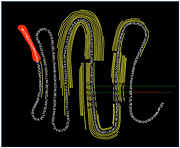- Number 327 |
- December 20, 2010
Protein pieces provide path toward early detection of breast cancer

Example of substrate cleavage
specificities for human plasma
protein Apolipoprotein A-IV.
Sequence encased in red is
the signal peptide; the
detected
peptides are represented by
the yellow curves.
Researchers at DOE’s Pacific Northwest National Laboratory and the University of Texas developed a new technique that may lead to discovering novel circulating biomarkers for early cancer detection. The strategy targets the blood plasma peptidome. The peptidome consists of small, naturally occurring proteins and protein fragments. By targeting the peptidome, the team comprehensively identified degradation products in proteins. Cancer-specific changes in protein degradation could provide markers that may enable earlier detection of cancer. Breast cancer is the most common malignancy in American women. In 2009, it was estimated that 192,000 American women would be diagnosed with breast cancers, and more than 40,000 would die from the disease. The work was performed in EMSL and funded by the National Institutes of Health’s National Center for Research Resources and DOE’s Office of Biological and Environmental Research.
[Kristin Manke, 509.372.6011,
kristin.manke@pnl.gov]
